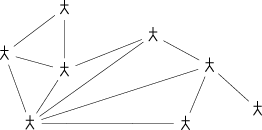Chapter 26, Outline
Introduction to Object Oriented Programming, 3rd Ed
Chapter 26
Distributed Computing
Outline
- Roadmap
- An Object Oriented Community
- Relaxing the Rules
- Client-Server Computing
- Making it Easier to write Client Sever Systems
- Next Level of Complexity
- Object Serialization
- Asking an Object About its State
- The Future
Other Material
Roadmap
In this chapter we will explore some of the implications of
programming in a distributed environment.
- network programming
- mobile programming
- component based programming
Intro OOP, Chapter 26, Slide 01
An Object Oriented Community
Recall that we have been asserting that an object-oriented program
is properly thought of as a member of a community

if we relax the rules for membership in this community, we move
the paradigm in different directions.
Intro OOP, Chapter 26, Slide 02
Relaxing the rules
What are some of the ways we can relax the rules?
- Allowing objects to be written in different languages -- (corba, dcom)
- Allowing objects on the same machine to form connections dynamically -- (java beans)
- Allowing objects to reside on different computers -- (distributed
computing)
- Allowing objects on different computers to form connections dynamically -- (mobile computing)
All of these are conceptually easy, but the devil is in the details.
Intro OOP, Chapter 26, Slide 03
Client-Server Computing
The simplest type of interaction is allowing objects to reside on
different computers, but with known interfaces.
This is termed client/server computing.
The book describes a simple client/server system.
Intro OOP, Chapter 26, Slide 04
Making it Easier to Write Client Server Systems
Java simplifies the production of client/server systems by providing
ready-made library routines for
- Address -- IP addresses or domain names.
- Ports -- an address in a computer for creating connections
- Sockets -- a connection between one computer and an address/port on
another computer
- Streams -- for reading from and writing to a socket.
Doesn't mean it can't be done in other languages, but Java makes
it a lot easier since they have spent a lot of time giving you simple
interfaces for these activities.
Intro OOP, Chapter 26, Slide 05
Next Level of Complexity
The next level of complexity is a general server who is ready to accept
connections from many clients, perhaps many at one time.
The book describes a system for this.
Intro OOP, Chapter 26, Slide 06
Object Serialization
Another useful feature (which should perhaps have been described in
the metaprogramming chapter) is the ability to transfer objects across
a network connection and regenerate them on the far side.
Called object serialization, sometimes marshalling.
Again, Java has a nice facility for this. Other langauges may as well,
but I'm less familiar with them.
The book gives an example of object serialization.
Intro OOP, Chapter 26, Slide 07
Asking an Object About its State
Moving back to a single machine, there are systems that allow a program
to dynamically inquire the capabilities of another class, and then
add it into a running program.
A good example is Java Beans, which is not described in the book.
Again, this is built on the reflection facilities described in
the previous chapter.
The programmer collects a bunch of components, then assembles
them into a new application. Often components have a visual
interface, and can be assembled using a visual tool, without needing
to write (much) programming.
Intro OOP, Chapter 26, Slide 08
Across a Network
The next level of complexity is to do the same sort of thing, but
allow the components to exist across the network.
This is part of what MS is trying to do with its dot-net program.
Allow the creation of components which can then be assembled even
when they exist on widely separated computers.
Many parts of this problem:
- Registration -- how do you find out what components exist out there?
- Interface Query -- how do you find out what interfaces these components
use
- Connection -- how do you make a dynamic connection with a remote object
- Interaction -- how do you communicate with a remote object
Each of these steps is at the moment unstandarized, but a lot of
effort is going into each. Expect a lot of work on this in the future.
Intro OOP, Chapter 26, Slide 09
The Future
I expect that in three years time this chapter will be a lot richer and
a lot thicker. There is an awful lot of work going on in this area
right now. Some of these ideas will be successful and continue,
some will die out and be replaced.
You should expect to be hearing more about distributing / network / web based
computing as time goes on.
Intro OOP, Chapter 26, Slide 10

